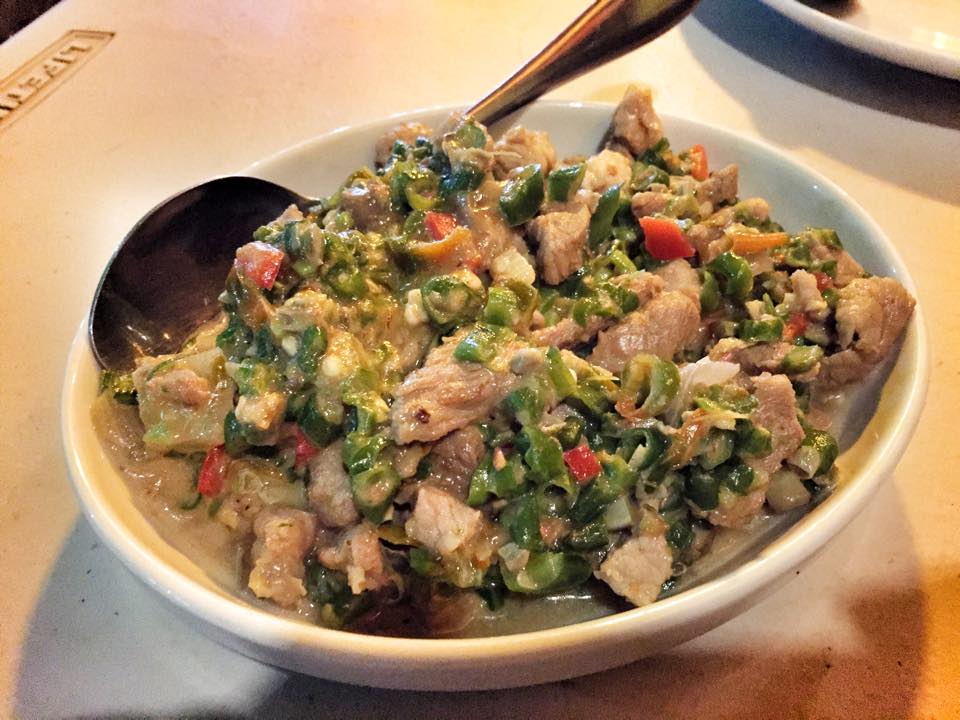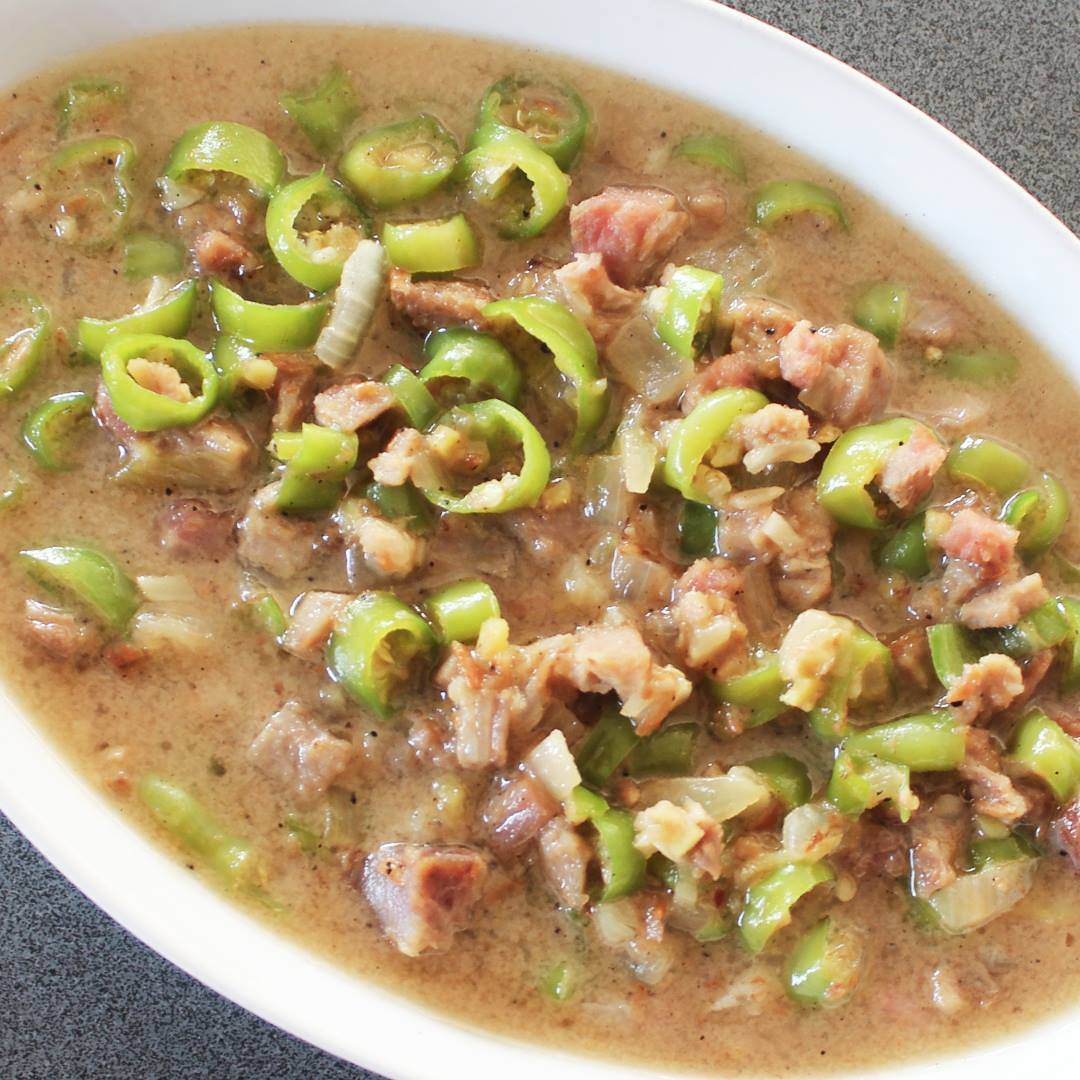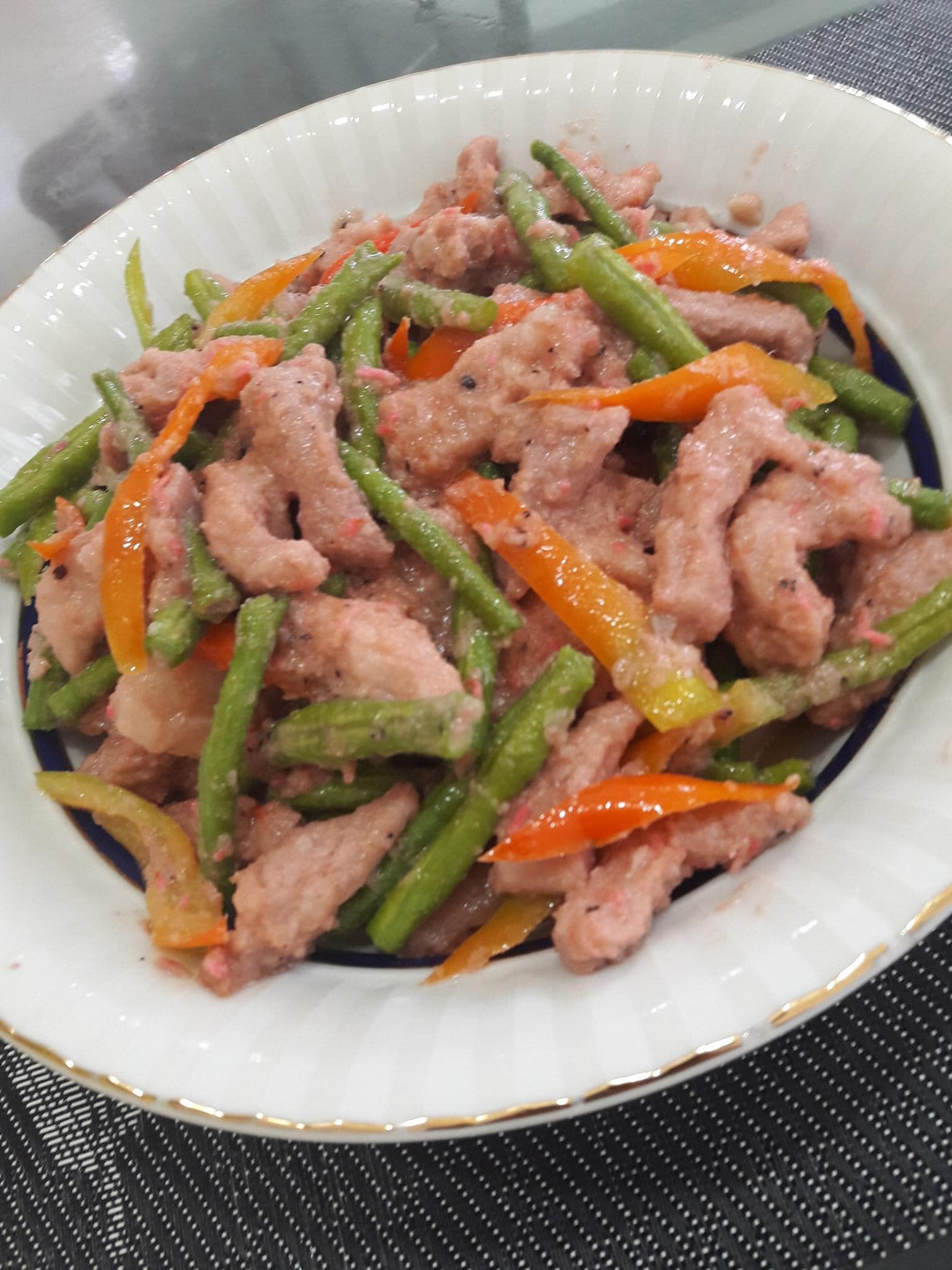Dear foreign readers, are you fond of spicy food? Allow Tita S to tell you 8 facts about a popular Filipino spicy dish.
1.Bicol Express is a Bicolano1–style stew made of pork chunks, siling haba2 or siling labuyo3, coconut milk4 (gata), shrimp paste (bagoong alamang5) or stockfish6, onion, ginger and garlic. It is enjoyed with steamed white rice.
Siling haba is used for those who have a low tolerance for spiciness. It can be soaked for 30 minutes in salted water, drained, and then cut into 1-inch slices. For the Bicolanos and others who prefer a very spicy dish, siling labuyo is used.
2. It is called Sinilihan (“spiced with chili”) in the Bicol7 region8.

Photo source: https://www.facebook.com/alejandroscrispypata/photos/928286173896074
3. The widely known name for this dish in the Bicol7 region8 was identified as Gulay na may Lada, an Ilocano9 dish made with exactly the same ingredients of the Bicol Express but without pork and shrimp paste. It is now considered one of the vegetarian variants of Bicol Express.
During the 1960s, this dish was sold in the Sipocot10 train station in the province11 of Camarines Sur12, in the Bicol region. The dish was stored in a plastic bag and the rice was wrapped in a bundle of taro leaves. Passengers were offered this treat when the train temporarily stopped there. Over time, as food selling on trains became prohibited on the Philippine National Railways (PNR) train lines, the relevance of this dish diminished.
4. However, Cely Kalaw, a Laguna13 resident with Bicolano1 upbringing, re-created and popularized the Bicol Express we now know during a cooking competition in the 1970s held in the district of Malate, in the city of Manila, using the ingredients I mentioned in fact 1. For those who do not know, most Bicolano dishes use coconut and chili peppers.
5. Its name was inspired by the Bicol Express railway train of the Philippine National Railways which operated from the train station in Tutuban, in the city of Manila, to the city of Legazpi, in the province11 of Albay, in the Bicol7 region8 of the Philippines.
The customers of Kalaw’s restaurant were requesting a spicy and sizzling dish, and while she was thinking of a name to her new dish, her brother heard the sound of the train nearby, thus, it was named Bicol Express, which she entered in a cooking competition.
6. How is this dish prepared?
Garlic, onion and ginger are sauteed in oil. The pork chunks are added and cooked until they turn light brown. Coconut milk4 is added, and the mixture is simmered for a few minutes. Siling haba2 or siling labuyo3 is then added. Shrimp paste or stockfish6 and coconut cream are added, and the mixture is simmered until it is reduced to your desired consistency, and the pork is tender and begins to render fat. It is transferred to a serving bowl, and served hot with a side of steamed rice.

Photo source: https://www.facebook.com/zubuchonphilippines/photos/1587507164689447
7. Eventually, other versions of Bicol Express were created:
* vegan – shiitake mushrooms or tofu, instead of pork; vegetable paste and gluten free soy sauce, instead of shrimp paste
* beef
* chicken
* seafood – crab, manta ray, shark, shrimp or tilapia are commonly used
The preparation varies according to the meat or main ingredient used.

Bicol Express with Sitaw – Photo source: https://www.facebook.com/camarinesnorteofficial/photos/958850138276683
8. The Llaguno family started to sell Bicol Express in glass jars in 2012. The Department of Science and Technology (DOST) helped the business by extending its shelf life for commercial production.
The information was obtained from the Wikipedia page “Bicol Express”.14
Now, Tita S will comment on this dish.
Bicol Express is one of my favorite Filipino dishes, although I have a low tolerance for spiciness. So, for people like me, I suggest that you use siling haba2, not siling labuyo3, and scrape off some of the seeds before mincing, to lessen the spiciness.
I consider this delicious and hearty dish to be rich, creamy and pleasantly spicy. I have the tendency to eat more steamed rice when I eat this dish.
I prefer fatty pork cuts like pork belly or shoulder, cut into 1-inch cubes. Definitely, do not omit the bagoong15. Personally, I want the taste of Bicol Express using fresh bagoong, instead of bagoong alamang5. However, to lessen the saltiness and remove the pink color of the fresh shrimp paste, rinse and drain well before using.
I recommend that you lower the heat to a simmer when you add the coconut milk4 and cream to avoid curdling and to ensure a smooth, creamy sauce.
When you want vegetables with this dish, you can use winged beans (sigarilyas) or yard-long beans (sitaw).
If you have leftovers, be sure it is no longer hot, place in a tight-fitting container, refrigerate, and it can keep for 2-3 days. And you know what? I like the taste of this dish even more the following day.
This is not a sponsored post. I just want my readers to know more about Philippine delicacies.
The photo featured in the cover photo was obtained from https://www.facebook.com/camarinesnorteofficial/photos/1026289104866119.
Did you find this post informative? I would like to hear your comment/s regarding Bicol Express.
See other interesting posts in this category (Pinoy Delights) and other categories – SCapades and Smart Travelers – Foreign Travelers Ask, Now You Know, and Say, Say, Say. Happy reading, and I hope that you will appreciate what I shared and some of the featured destinations will be part of your future travel plans!
Remember to share this post with your Facebook friends, and to follow me by clicking on the bottom right corner of your device. And, do not forget to like this post. Thank you.
– – – – – – – – – – – – – – – – – – – – – – – – – –
The following terms are defined for interested readers, especially those with “Senior-Moments”, those not familiar with Filipino terms, and those too busy or lazy to Google such terms:
1A Bicolano is a native inhabitant of the Bicol7 region8. It is also an adjective referring to anything related to the said region (e.g., language spoken, dishes).
2Siling haba is a kind of long chili which is light green in color and belongs to the species Capsicum annuum. It is mildly spicy and is commonly used in Filipino dishes, especially in Sinigang (a sour soup), Paksiw (meat or fish in a vinegar broth), Dinuguan (Pork Blood Stew), and Kinilaw (Philippine ceviche). It is also called espada, finger chili, green chili, long pepper, and siling mahaba, siling pangsigang, siling Tagalog. The information was obtained from the Wikipedia page “Siling haba”.16
3Siling labuyo, or simply labuyo, is a small chili pepper that developed in the Philippines after the Columbian Exchange17. It belongs to the species Capsicum frutescens and is characterized by triangular, very pungent fruits which grow pointing upwards. Siling labuyo is a Tagalog term meaning “wild chili”. The information was obtained from Wikipedia page “Siling labuyo.”18
4Coconut milk is the opaque, milky-white liquid extracted from the grated pulp of mature coconuts. It is the traditional ingredient used in Southeast Asia, East Africa, Oceania and South Asia. It is also used in the Caribbean, tropical Latin America and West Africa.
There are two extractions. The first is thick and concentrated coconut milk and is called coconut cream. The second extract is thinner or watery and is also called coconut milk.
The information was obtained from the Wikipedia page “Coconut milk”.19
5Bagoong alamang is a kind of bagoong15 prepared by initially cleaning the krill20 (alamang) thoroughly then washing it in a weak (10%) brine solution. The krill is then mixed with salt in a 25% salt to 75% krill ratio by weight.
The mixture is kept covered, inside large earthen fermentation jars (tapayan in Tagalog and Visayan, or burnay in Ilocano) and left to ferment for 1 – 3 months, with occasional stirring to make sure that the salt is evenly spread.
Patis, the liquid on top, is skimmed, leaving the fermented krill, which is bagoong alamang. At this point, it is usually pale grey to white in color. This bagoong is traditionally colored pink or red through the addition of angkak21.
It is called uyap or alamang in southern Philippines, aramang in Ilocos and parts of Northern Luzon, and ginamos or dayok in Western Visayas.
The information was obtained from the Wikipedia page “Bagoong”.22
6Stockfish is unsalted dried fish, especially cod, dried by cold air and wind on wooden racks, usually done by fishermen and their families. The fish is cured through fermentation where cold-adapted bacteria matures the fish, similar to the maturing process of cheese. The information was obtained from the Wikipedia page “Stockfish”.23
7Region V, or Bicol Region, is a Philippine region8 located in the island group of Luzon, located at the northern part of the Philippine archipelago. Legazpi as its regional center and largest city. It has 6 provinces11: Albay, Camarines Norte, Camarines Sur12, Catanduanes, Masbate, and Sorsogon. It is called the “Home of the Uragons”, referring to the brave Bicolano people.
This region is bounded by the Lamon Bay to the north, the Ragay Gulf to the west, and the Philippine Sea to the east. Camarines Norte and Camarines Sur, the northernmost provinces, are bordered to the west by the province of Quezon (of the Calabarzon region).
The information was obtained from the Wikipedia page “Bicol Region”.24
8A region is the first-order administrative division in the Philippines. There are 17 regions in the Philippines, based on geographical, cultural and ethnological characteristics. It is further subdivided in provinces11, composed of cities and minicipalities25, which in turn, are divided into barangays26 (district or village). The information was obtained from the Wikipedia page “Regions of the Philippines.”27
See a related post: Foreign Seniors Ask: WHAT ARE THE REGIONS OF THE PHILIPPINES?
9An Ilocano is a native inhabitant of the Ilocos region, located in the northern part of the Philippine archipelago. It is also an adjective referring to anything related to the said region (e.g., language spoken, song, food or drink).
10Sipocot is a municipality25 in the province11 of Camarines Sur12, in the Bicol7 region8, in the island group of Luzon, located at the northern part of the Philippine archipelago. It is called the Egg Basket of Camarines Sur and the Native Chicken Capital of Camarines Sur. It was founded on July 3, 1801. It is composed of 46 barangays26. The information was obtained from the Wikipedia page “Sipocot”.28
11A province is the primary administrative and political division in the Philippines. It is the second-level administrative sub-division of a region8. There are 81 provinces (called lalawigan) in the Philippines. Each province is governed by an elected legislature called the Sangguniang Panlalawigan and by an elected governor. The information was obtained from Wikipedia page “Provinces of the Philippines.”29
See a related post: Foreign Seniors Ask: WHAT ARE PROVINCES IN THE PHILIPPINES?
12Camarines Sur is a province11 in the central part of the Bicol7 region8, in the island group of Luzon, located at the northern part of the Philippine archipelago. It is the largest among the 6 provinces in the region, both by population and land area. It borders the provinces of Camarines Norte and Quezon to the northwest, the island province of Catanduanes, across the Maqueda Channel, to the east, and the province of Albay to the south. It was founded in March 19, 1919.
Its capital is the municipality25 of Pili. It is composed of 2 cities, Naga and Iriga, and 35 municipalities (or towns). The economy of this province is mostly agriculture-based, where 29 or the 35 towns are agricultural and produce rice, corn, feedmeal, freshwater fish, livestock, coconut, sugar, abaca and water lily.
The information was obtained from Wikipedia page “Camarines Sur.”30
13Laguna is a province11 in the Calabarzon Region8 of the Philippines, located southeast of Metro Manila, north of the province of Batangas, west of the province of Quezon, south of the province of Rizal, and east of the province of Cavite. This is the 7th richest province in the Philippines, and the third largest province in the region. It hugs the southern shores of Laguna de Bay, the largest lake in the country. It is composed of 24 municipalities25 and 6 cities. The provincial capital is the town of Santa Cruz since 1858, after Bay (1581-1688) and Pagsanjan (1688-1858). It is historically one of the first provinces in the Philippines to have been visited by Christian missionaries. Its main natural resources are its agriculture and fisheries, owing to its position near Laguna de Bay and the surrounding lowlands. The information was obtained from the Wikipedia page “Laguna (province)”.31
14“Bicol Express,” accessed July 26, 2018, https://en.wikipedia.org/wiki/Bicol_Express post
15Bagoong is a Philippine condiment, partially or completely, made of fermented fish or krill40, and oysters, clams and even fish/shrimp roe, and salt. The by-product of fermentation is the resulting yellowish liquid which is skimmed and called patis (fish sauce).
There are several kinds: bagoong isda (fermented fish – sardines, anchovies, the fry of larger fish), bagoong alamang5 (fermented krill), as well as the rarer bagoong macabebe (fermented oysters) and bagoong sisi (fermented clams).
The preparation of bagoong varies regionally in the Philippines. See https://en.wikipedia.org/wiki/Bagoong for more information.
The information was obtained from the Wikipedia page “Bagoong”.22
16“Siling haba,” accessed July 26, 2018, https://en.wikipedia.org/wiki/Siling_haba
17The Columbian Exchange, or the Columbian Interchange, was the widespread transfer of plants, animals, culture, (free and enslaved) human populations, technology, diseases, and ideas between the Americas and the Old World in the 15th and 16th centuries. It is named after Christopher Columbus, and is related to European colonization and trade following his 1492 voyage. This term was first used in 1972 by the American historian Alfred W. Crosby in his environmental history book “The Columbian Exchange”. It was rapidly adopted by other historians and journalists. The information was obtained from Wikipedia page “Columbian Exchange”.32
18“Siling labuyo,” accessed July 26, 2018, https://en.wikipedia.org/wiki/Siling_labuyo
19“Coconut milk,” accessed July 26, 2018, https://en.wikipedia.org/wiki/Coconut_milk
20Krill are small crustaceans of the order of Euphausiacea, and are found in all the world’s oceans. The term comes from the Norwegian word krill, meaning “small fry of fish”, which is often attributed to species of fish. Near the bottom of the ocean’s food chain, they feed on phytoplankton and even zooplankton, and are the main source of food for many larger animals (e.g., whales, seals, penguins, squids and fishes), especially near the surface of the water at night, and in deeper waters during the day. Most are caught for aquaculture and aquarium feeds, as bait in sport fishing, or in pharmaceutical industry. In the Philippines, krill is known as alamang and used to make a salty paste called bagoong15. The information was obtained from the Wikipedia page “Krill”.33
21Angkak, red yeast rice, red rice koji, red fermented rice, red kojic rice, red koji rice, or anka, is a bright reddish purple fermented rice which acquired its color from the inoculation of the species of red mold (Monascus purpureus). Note that koji is the Japanese term for “grain or bean overgrown with a mold culture”.
Angkak is the Filipino term for red yeast rice and is widely used in the Philippines to traditionally color and preserve certain dishes like bagoong alamang5 (fermented shrimp), burong isda (fermented rice and fish), and balao-balao (fermented rice and shrimp).
The information was obtained from the Wikipedia page “Red yeast rice”.34
22“Bagoong,” accessed July 26, 2018, https://en.wikipedia.org/wiki/Bagoong
23“Stockfish,” accessed July 26, 2018, https://en.wikipedia.org/wiki/Stockfish
24“Bicol region,” accessed July 26, 2018, https://en.wikipedia.org/wiki/Bicol region
25A municipality is a small, single urban administrative division, or local government unit (LGU)27, in the Philippines which has corporate status and powers of self-government or jurisdiction as granted by law. It is a unit under a province11, subdivided into barangays26, and is called town, or bayan. In the Philippines, a municipality is headed by a mayor, a vice mayor and members of the Sangguniang Bayan (legislative branch). The information was obtained from Wikipedia page “Municipalities of the Philippines.”35
26A barangay is the smallest administrative division in the Philippines, headed by a barangay captain, aided by a Sangguniang Barangay (Barangay Council). It is the native Filipino term for a district or village. It was formerly called a barrio. In a metropolitan area, a barangay is an inner city neighborhood, a suburb, or a suburban neighborhood. The word barangay originated from the term balangay, a kind of boat used by a group of Austronesian people who migrated to the Philippines. A number of barangays grouped together is called a district. The information was obtained from Wikipedia page “Barangay.”36
27“Regions of the Philippines,” accessed July 26, 2018, https://en.wikipedia.org/wiki/Regions_of_the_Philippines
28“Sipocot,” accessed July 26, 2018, https://en.wikipedia.org/wiki/Sipocot
29“Provinces of the Philippines,” accessed July 26, 2018, https://en.wikipedia.org/wiki/Provinces_of_the_Philippines
30“Camarines Sur,” accessed July 26, 2018, https://en.wikipedia.org/wiki/Camarines Sur
31“Laguna (province),” accessed July 26, 2018, https://en.wikipedia.org/wiki/Laguna_(province)
32“Columbian Exchange,” accessed July 26, 2018, https://en.wikipedia.org/wiki/Columbian_exchange
33“Krill,” accessed April 2, 2018, https://en.wikipedia.org/wiki/Krill
34“Red yeast rice,” accessed April 2, 2018, https://en.wikipedia.org/wiki/Red_yeast_rice
35“Municipalities of the Philippines,” accessed July 26, 2018, https://en.wikipedia.org/wiki/Municipalities_of_the_Philippines
36“Barangay,” accessed July 26, 2018, https://en.wikipedia.org/wiki/Barangay

